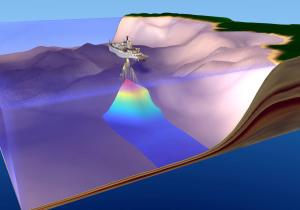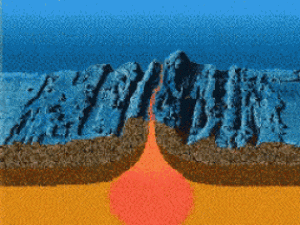Sea Floor Spreading
In this section, we are going to take Alfred Wegener's thoughts a little further. Let's explore another idea called seafloor spreading.
Click here if you are a student at Snowflake, Heber, or Holbrook to access the SUSD5 Student Version of Seafloor Spreading assignment.
Purchase this Seafloor Spreading activity at Teachers Pay Teachers for $1.50 cents.
If you complete the assignment above you would have already read the next 3 paragraphs.
Alfred Wegener had this other idea that maybe the seafloor was moving outward from ocean centers. He never really pursued that thought though. In the 1960’s Harry Hess, a Navy Captain figured that ocean floors moved away from their centers from long volcanically active ocean ridges.

Hess had equipment that Wegener did not have. Hess had access to a ship and sounding equipment. Due to the invention of Echo-Sounding, the ocean floor began to be mapped. What researchers discovered was that there were ridges found in the center of oceans. They found that the ocean floor was not flat as previously expected.
In 1968 the Glomar Challenger, a deep-sea research vessel, set out to collect drilling samples from around the world. Scientists found some interesting information about the age of the rocks on the ocean floor. As technology advanced, scientists also discovered that water temperature near the center of these ridges was warmer than water further from the ridge.
Hess put forth the idea that maybe hot less dense material in the mantle rises to the surface near ocean ridges and then turns and flows sideways dragging the crust with it. As the seafloor spread apart, the crust thins stretches and cracks allowing molten material to rise out, cool harden, and turn into a ridge as demonstrated by the animation below.
As the Glomar Challenger studied and mapped the rocks on the ocean floor, Hess discovered that there weren't any rocks older than 180 million years. He also noticed that rocks near the mid-ridges were younger and got progressively older the closer they got to the shore.
Scientists also found out something interesting about Earth's magnetism over time. Based on evidence found in iron-bearing basalt rock or magnetite, it looked like the Earth's magnetic north pole wasn't always in the north. It turns out that every few million years the magnetic field reverses on Earth. This happens because elements of iron in the basalt come out of the ridges and align themselves with the orientation of the magnetic field. Scientists used magnetometers and recorded magnetic data. They discovered that the alignment in the rocks was reversed back and forth in strips along the seafloor. If the magnetic alignment is pointed north it is called normal polarity. If the magnetic alignment is pointed south, then it is called reversed polarity.
Seafloor spreading helped support the Continental Drift hypothesis because Hess came up with a mechanism that could move the crust around.















